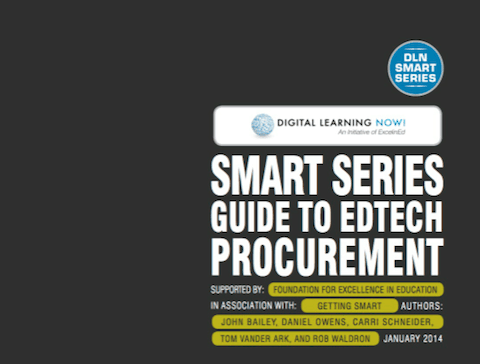Smart Procurement

By: Tom Vander Ark & Rob Waldron
The good news is that the learning opportunity set is rapidly improving–devices are getting cheaper, learning systems are becoming adaptive, and new school models are blending the best of online and face-to-face instruction. The bad news is that all this new technology has created a purchasing headache. It’s hard to know what to buy and how to make everything work together.
Procurement in the highly decentralized U.S. K-12 education system has always been challenging, but the explosion of web and mobile applications has compounded these challenges in the last 3 years. We are both encouraged by the investment and innovation in the EdTech sector but concerned that purchasing remains complicated and inefficient. We agreed the sector would benefit from a guide that lays out a plan for EdTech procurement — that helps schools save money and that maximize the potential to bring the best EdTech to students.
This time last year, Getting Smart partnered with Digital Learning Now! (DLN) to create the first Blended Learning Implementation Guide (BLIG). The Guide set out to help school and district leaders think through the key decisions in planning for the shift to blended learning.
After putting together the first iteration of the BLIG and hearing from leaders who were using it, we quickly learned that schools and districts were looking for more guidance on purchasing edtech.
In August, Rob Waldron, CEO of Curriculum Associates (CA) posted the Top Ten Ways to Save Money on EdTech and a future white paper was born. In September, The Learning Accelerator (TLA) joined the BLIG party, and we launched the Blended Learning Implementation Guide 2.0 that featured Rob’s list.
Today we’re taking the next step with the launch of the ” Smart Series Guide to EdTech Procurement “ co-authored by DLN’s John Bailey, Getting Smart’s Carri Schneider & Tom Vander Ark and contributing authors Rob Waldron of CA and Daniel Owens from TLA. The Guide is based on lessons gleaned by the collective experience of the authors who have worked with hundreds of school districts across the nation.
The goal of the Guide is to create a framework for EdTech purchasing by offering practical advice to guide key decisions, sharing lessons learned from districts that have already made the digital shift, discussing the implications for blended learning, and providing examples of best practices in education policy that support smart procurement.
These 12 keys, also featured on the ” Smart EdTech Requires Buying Smart” infographic, are:
- Take inventory
- Determine the educational priorities
- Exercise caution on customization
- Pursue collaborative investigation and purchases
- Demand guarantees and assurances
- Make real comparisons
- Conduct a pilot
- Prioritize data sharing and interoperability
- Remember that service matters
- Consider total cost of ownership
- Close the deal
- Implement, implement, implement
The Guide also includes a robust policy section that calls for the modernization of procurement policy. “Procurement policies and practices are one of the most overlooked areas needed to support innovative instructional models,” said John Bailey, executive director of Digital Learning Now! “We can’t transform our education system without transforming the way we procure services and products. Procurement needs to accelerate new approaches, not inhibit them.”
To learn more or to download the full paper, go to digitallearningnow.com/dln-smart-series or follow along on social media using the hashtags #SmartSeries, #EdTech and #DigLN.
Digital Learning Now! and Curriculum Associates are Getting Smart Advocacy Partners.








0 Comments
Leave a Comment
Your email address will not be published. All fields are required.